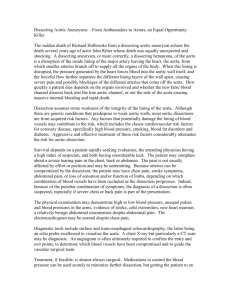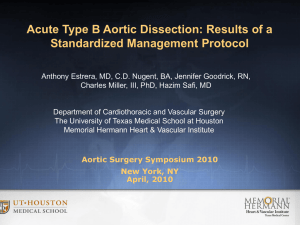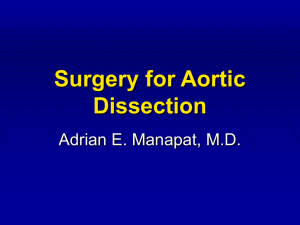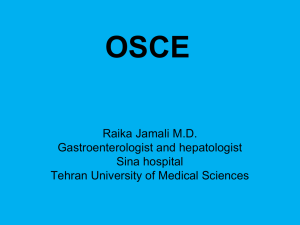Approach to the ED Patient with Chest Pain
advertisement
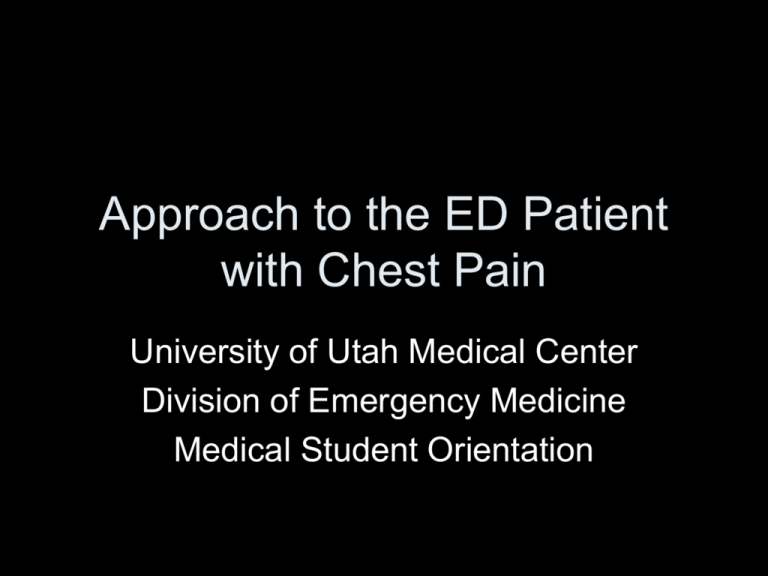
Approach to the ED Patient with Chest Pain University of Utah Medical Center Division of Emergency Medicine Medical Student Orientation The Stats •5.4% of all ED visits –High volume –High risk •$$$ malpractice claims –Misdiagnosis –Delay in treatment •< 1/3 have myocardial ischemia or infarction Common Etiologies of Life-threatening Chest Pain 1. 2. 3. 4. 5. 6. Acute MI Unstable angina Aortic Dissection Pulmonary Embolism Spontaneous Pneumothorax Esophageal Rupture (Boerhaave’s Syndrome) Acute MI Acute MI • • HPI Typical Symptoms ––Onset Crescendo pain • Crushing – Palliates/Provokes • Pressure – Quality • Tightness ––Radiation Radiation • Arms – Severity • Jaw – Time course • Neck ––Undo (whatSymptoms have they Associated done to “undo” their • Nausea pain) • Vomiting • Diaphoresis • Shortness of breath • • PMHx Risk Factors – –Med HTNHx • HTN – Diabetes • DM – High cholesterol • Cholesterol – Obesity – Meds – Male – FHx – Family history • Immediate relatives CAD Smoker – –Social Hx – Sedentary • Tobacco – Post-menopausal • Drugs • Exercise • Stressors Acute MI • But don’t be fooled – Atypical symptoms • Stridor • Tooth pain • Headache/neck pain – Atypical demographics • Young • Female – Cocaine use – Dissection • Aorta • Coronary arteries Initial Work-up • ECG/repeat ECG – before you even step foot in the room! • CXR • Labs Enzyme Rise Peak Baseline Myoglobin 1-2 h 4-6 h 24 h Troponin 3-6 h 12-24 h 7-10 d CKMB 4-6 h 12-36 h 3-4 d LDH 12 h 24-48 h 10-14 d • STEMI ECG – 1mm ST elevation in 2 limb leads – 2mm ST elevation in two contiguous anterior leads – Reciprocal changes • Ischemia – ST flattening – ST depression Treatment • Anti-platelet – ASA – Plavix • Heparin • Analgesia – Nitrates – Narcotics • B-blockade – No longer recommended in STEMI patients • Oxygen • Thrombolytics vs. Cath Lab Missed MI • ~ 2% missed infarction rate – 25% had missed ST elevation – 15% had Hx of nitroglycerin use – 25% died or potentially lethal outcome! Unstable Angina Angina vs. MI • Heart muscle – death in MI – Ischemia in angina • Stable vs. Unstable Angina Presentation of Angina • Angina – Established character, timing, duration of CP – Transient, reproducible, predictable – Easily relieved by rest or SL NTG – Reduced coronary flow through fixed atherosclerotic plaques • Unstable Angina – Angina deviating from normal pattern – Rest angina > 20 min – New-onset angina, previously undiagnosed – Increasing angina or change in class Evaluation • • • • • Detailed history Physical ECG/repeat ECG CXR Labs Risk Stratify While this is recommended, exactly how to do it is controversial. There are several scoring systems. They each pros and cons. How risk stratification is will vary from institution to institution. • TIMI score • GRACE • Braunwald Risk Stratification Risk Stratify • High/Moderate = admission to r/o MI – ASA – SL NTG for pain x3 then paste if pain free – NTG gtt if pain continues – IV heparin – B-blockade • Low = provocative testing – From department – Low-risk obs pathway Aortic Dissection Aortic Dissection • 25-50% mortality in 24 hours Aortic Dissection-Typical Symptoms • • • • • • • Onset Palliates/provokes Quality Radiation Severity Time course Undo • • • • • • • sudden, chest/back nothing! intense ripping, tearing, cutting chest to back, flank, extremities 10/10! Constant nothing Aortic dissection-caveat • Only about 30% present typically • This can be a great mimicker • Neurologic sx’s + CP = think about dissection Aortic Dissection • Risk Factors – – – – – – – – – Trauma (high velocity) HTN Men 3:1 Congenital abnormal aortic valve Coarctation of aorta Turner’s Syndrome Cocaine Pregnancy Connective tissue d/o • Marfan’s • Ehlers-Danlos – Vascular damage • Card cath, CABG, IABP Aortic Dissection • Physical Exam – Aortic regurgitation (diastolic murmur) – Loss/decreased pulse – Sternoclavicular heave/pulsation – JVD • tamponade Aortic Dissection • Evaluation – CXR – ECG – TEE – MRI – CT CXR findings • • • • • • Dilated ascending aorta Dilated aortic knob Apical pleural cap Depression of L mainstem bronchus Displacement of trachea to R Widened mediastinum Sensitivity of 67% 93% Sensitivity 87% Specificity 98% Sensitivity 97% Specificity 97% Sensitivity 77% Specificity LVH, Infarct, Ischemia Aortic Dissection • Initial Management – Control HTN and shear forces = IV infusions • B-blocker + Nitroprusside • Labetalol • Cardiothoracic Surgery Consult – For dissections involving the aortic root Type 1: ascending & descending; Type 2: ascending only; Type 3: Descending only; Type A: Ascending aorta; Type B: Descending aorta Aortic Dissection • Suggested reading (IRAD): – “The International Registry of Acute Aortic Dissection: New Insights Into an Old Disease” JAMA Feb 16, 2000 Vol 283 No 7. Pulmonary Embolism To be discussed in another lecture Spontaneous Pneumothorax Spontaneous Pneumothorax • Absence of trauma • Primary = no lung disease • Secondary = underlying lung disease Pneumothorax • Presentation may vary – Sudden onset • Sharp, pleuritic pain, radiates to shoulder – Gradual symptoms • Progressive dyspnea over weeks… Spontaneous Pneumothorax • Risk Factors – – – – Smoker:Non-smoker 120:1 COPD/asthma Malignancy Infectious • Abscess • TB • PCP – Pulmonary infarction – Pneumonoconiosis • Silicosis • Berylliosis – Congenital disease • Cystic fibrosis • Marfan’s – Diffuse lung disease • • • • • • Idiopathic Pulm fibrosis Eosinophilia granuloma Scleroderma Rheumatoid Sarcoid Etc. Spontaneous Pneumothorax • Physical exam – Absence or decreased breath sounds – Tension pneumothorax • • • • • Cyanosis Tachypnea Tachycardia Hypotension JVD Spontaneous Pneumothorax • Imaging – CXR • Visceral pleural line • +/- Expiratory film – CT Scan • Help w/size • Cause Pneumothorax • Treatment – oxygen – <15% = observation – >15% = chest tube vs. aspiration Recurrence is common ~ up to 50% in 2-3 yrs. Esophageal Rupture Esophageal Rupture Boerhaave’s Syndrome • Complete tear • Esophageal contents leak into mediastinum • Mediastinitis • SICK! Esophageal Rupture • Presentation – Chest and neck pain – Often recent instrumentation of esophagus – Hx of forceful vomiting Esophageal Rupture • Evaluation & Diagnosis – Subcutaneous emphysema – Hammon’s Sound – Pleural effusion – CXR – CT – Esophagram Esophageal Rupture • Management – Surgical! – 80-90% survival if fixed within 24 hours Chest Pain Summary • • • • • High index of suspicion Broad differential Risk stratification Evidence-based medicine Do what is right for your patient



